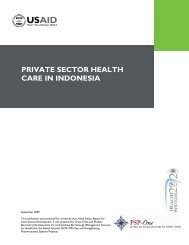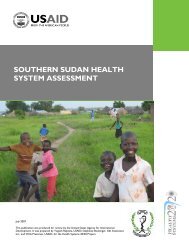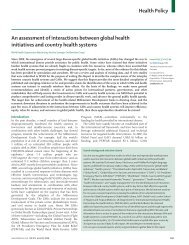Case Study on Piloting Complex Health Reforms in ... - PHRplus
Case Study on Piloting Complex Health Reforms in ... - PHRplus
Case Study on Piloting Complex Health Reforms in ... - PHRplus
Create successful ePaper yourself
Turn your PDF publications into a flip-book with our unique Google optimized e-Paper software.
1. Introducti<strong>on</strong><br />
The purpose of this case study is to c<strong>on</strong>tribute to greater understand<strong>in</strong>g of the process of pilot<strong>in</strong>g<br />
health reform <strong>in</strong>itiatives as part of broader health system reform efforts. The USAID-funded Partners<br />
for <strong>Health</strong> Reform Plus (<strong>PHRplus</strong>) Project seeks to advance knowledge of health reforms and their<br />
impact, as well as to promote the exchange of <strong>in</strong>formati<strong>on</strong> <strong>on</strong> critical health reform issues. A recent<br />
<strong>PHRplus</strong> review of experience <strong>on</strong> pilot<strong>in</strong>g heath systems reform f<strong>in</strong>ds that the process of pilot<strong>in</strong>g<br />
complex health reform has been poorly documented, provid<strong>in</strong>g little guidance <strong>on</strong> when pilots may be<br />
an appropriate strategy to test new <strong>in</strong>itiatives, or how pilots should be designed to meet the needs of<br />
different c<strong>on</strong>texts (Bennett and Paters<strong>on</strong>, 2003). The review paper suggests a framework for<br />
improv<strong>in</strong>g the documentati<strong>on</strong> of pilots, so that valuable <strong>in</strong>formati<strong>on</strong> <strong>on</strong> pilot design and<br />
implementati<strong>on</strong> might be collected and shared. This case study attempts to document the use of a pilot<br />
approach to implement health reform <strong>in</strong> Kyrgyzstan.<br />
The c<strong>on</strong>cept of pilot<strong>in</strong>g has been used effectively <strong>in</strong> implement<strong>in</strong>g health sector reform<br />
throughout the former Soviet Uni<strong>on</strong>. One of the first pilots <strong>in</strong> Central Asia, established <strong>in</strong> 1994 <strong>in</strong><br />
Issyk-Kul oblast (prov<strong>in</strong>ce or state) <strong>in</strong> Kyrgyzstan (Figure 1), c<strong>on</strong>t<strong>in</strong>ues to provide valuable<br />
<strong>in</strong>formati<strong>on</strong> <strong>on</strong> the process of pilot<strong>in</strong>g complex health reforms. The <strong>in</strong>itial objective of the pilot was to<br />
provide the Kyrgyz government with a dem<strong>on</strong>strati<strong>on</strong> of a planned social health <strong>in</strong>surance model.<br />
Dur<strong>in</strong>g the design phase, the pilot quickly evolved <strong>in</strong>to a broader health reform effort aimed at<br />
strengthen<strong>in</strong>g the primary care sector and downsiz<strong>in</strong>g an <strong>in</strong>efficient hospital sector to <strong>in</strong>crease health<br />
system efficiency given exist<strong>in</strong>g resources, while simultaneously improv<strong>in</strong>g capacity at local and<br />
nati<strong>on</strong>al levels to implement complex health reforms and <strong>in</strong>troduce social health <strong>in</strong>surance.<br />
Some early experiences and less<strong>on</strong>s learned from the Issyk-Kul pilot site fed <strong>in</strong>to the c<strong>on</strong>current<br />
development of a nati<strong>on</strong>al health reform strategy (the MANAS Program). Over time, the development<br />
of the nati<strong>on</strong>al strategy provided the top-down political support necessary for c<strong>on</strong>t<strong>in</strong>u<strong>in</strong>g,<br />
strengthen<strong>in</strong>g, and roll<strong>in</strong>g out pilot activities <strong>in</strong> Issyk-Kul oblast. Even though the Issyk-Kul pilot<br />
project was never rigorously evaluated, the model that was tested was modified and ref<strong>in</strong>ed based <strong>on</strong><br />
implementati<strong>on</strong> experience, rolled out to two additi<strong>on</strong>al oblasts after two years with assistance from a<br />
World Bank loan project, and eventually rolled out nati<strong>on</strong>ally. Experience and less<strong>on</strong>s learned <strong>in</strong><br />
Issyk-Kul oblast with establish<strong>in</strong>g a health <strong>in</strong>surance fund were used to establish a nati<strong>on</strong>al health<br />
<strong>in</strong>surance fund <strong>in</strong> late 1996 and early 1997.<br />
An achievement greater than nati<strong>on</strong>al roll-out, however, may be the M<strong>in</strong>istry of <strong>Health</strong>’s<br />
sophisticated appreciati<strong>on</strong> for the role and use of pilots <strong>in</strong> develop<strong>in</strong>g and ref<strong>in</strong><strong>in</strong>g its policies. This<br />
appreciati<strong>on</strong> can be attributed to a cadre of capable and progressive reform stakeholders at oblast and<br />
nati<strong>on</strong>al levels, rigorous nati<strong>on</strong>al-level capacity build<strong>in</strong>g by the World <strong>Health</strong> Organizati<strong>on</strong> (WHO),<br />
USAID, and other d<strong>on</strong>ors, and hands-<strong>on</strong> experience implement<strong>in</strong>g and evaluat<strong>in</strong>g the Issyk-Kul pilot<br />
<strong>in</strong> stages. Recently, the M<strong>in</strong>istry of <strong>Health</strong> (MOH) has piloted c<strong>on</strong>t<strong>in</strong>uous quality improvement<br />
processes, a s<strong>in</strong>gle-payer f<strong>in</strong>anc<strong>in</strong>g model, an outpatient drug benefit for the <strong>in</strong>sured, and new models<br />
of provid<strong>in</strong>g emergency care and ambulance services, with great success. In c<strong>on</strong>trast to the Issyk-Kul<br />
oblast pilot, these pilots aimed to test and ref<strong>in</strong>e more specific and narrow health reform <strong>in</strong>terventi<strong>on</strong>s<br />
and they have been more rigorously evaluated by the MOH and the Mandatory <strong>Health</strong> Insurance Fund<br />
1. Introducti<strong>on</strong> 1

















